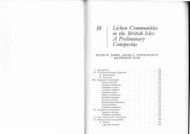You also want an ePaper? Increase the reach of your titles
YUMPU automatically turns print PDFs into web optimized ePapers that Google loves.
The most important sample points were plotted<br />
onto topographic charts.<br />
Voucher collections (lichen specimens) are<br />
deposited in the herbarium <strong>of</strong> the Public Museum<br />
for Nature Study, Stuttgart (STU).<br />
5.4 Consideration <strong>of</strong> Old Data Found<br />
Numerous botanists and amateurs have in the<br />
past, through their collecting, contributed to a<br />
truly solid lichenological knowledge <strong>of</strong> the<br />
region <strong>of</strong> <strong>Baden</strong>-<strong>Württemberg</strong>, though the<br />
research was very uneven and the inconspicuous<br />
species are strongly under represented. From the<br />
published finds and the vouchers deposited in<br />
herbaria it appears that many species are, since<br />
that time extinct or strongly decreased (see topic<br />
1.3). Since earlier a systematic inclusion <strong>of</strong><br />
lichen occurrences was not given and as a rule<br />
only a narrow vicinity around home and some<br />
few excursion areas were collected, are also<br />
single discoveries outside the today proven areas<br />
<strong>of</strong> definite reference from one in the interval<br />
following shrinkage <strong>of</strong> the area <strong>of</strong> distribution;<br />
even less the climatic and edaphic divergence <strong>of</strong><br />
the former habitat from the wider surroundings,<br />
all the more in all likelihood the evidence is<br />
representative and not an isolated discovery.<br />
To document the decrease <strong>of</strong> lichens,<br />
herbarium data and reliable published statements<br />
were assimilated for the raster point charts and<br />
were emphasized with special signatures.<br />
Different time ranges were differentiated:<br />
1. recorded previous to 1900,<br />
2. recorded in the time range 1900 to 1949,<br />
3. recorded from 1950 to 1974,<br />
4. recorded after 1975<br />
Actual occurrences have “priority” over old<br />
records in the same base field. A regression <strong>of</strong><br />
area is documented accordingly by the<br />
corresponding symbol for old discoveries in the<br />
chart picture. Although the regression <strong>of</strong> lichens<br />
in the last hundred years has taken a dismaying<br />
dimension, it can be expressed only in especially<br />
grave cases because <strong>of</strong> the relatively coarse<br />
ordinance survey raster in the chart picture, since<br />
it <strong>of</strong>ten still has retained the residue population.<br />
5.5 Consideration <strong>of</strong> Anthropogenic Habitat<br />
As laid out in topic 1.3, numerous species have<br />
found new habitats on human created substrates,<br />
such as grave- and boundary-stones, walls and<br />
monuments or ro<strong>of</strong> tiles. It is <strong>of</strong> interest in area<br />
information to document, as an addition to the<br />
occurrence <strong>of</strong> a rock lichen on their spreading to<br />
such anthropogenic substrates. There were<br />
plotted separately in the distribution charts<br />
numerous species which are restricted to such<br />
anthropogenic substrates (used smaller than<br />
normal size point). So the natural and that area<br />
conquered, thanks to man, can to a certain extent<br />
be differentiated.<br />
6 Glossary<br />
Notice: Ecological and plant geographical terms<br />
were treated extensively in the previous topic.<br />
adventitious, adentitious plants: Plants which<br />
only immigrate with human assistance; not<br />
originally occurring in the floral region.<br />
Algal layer: in most lichens the algae lie in an ±<br />
continuous layer near the upper surface.<br />
amyloid: colored blue or violet by I (iodine).<br />
anastomosing: in the case <strong>of</strong> paraphyses:<br />
reticulate bound.<br />
angiocarp: fruiting body, in which the<br />
hymenium is enclosed until the asci are ripe;<br />
hemiangiocarp: fruiting body enclosed at first,<br />
in which the hymenium to begin with is covered<br />
by a protective layer, which when fully mature<br />
frees the asci.<br />
anisotomic: branching type; branching in a rather<br />
long and <strong>of</strong>ten thick main axis and in one (or<br />
more) shorter and weaker side axis.<br />
anticlinal: perpendicular to the upper surface.<br />
apical: at the tip, toward the tip.<br />
apical structure: structure at the tip <strong>of</strong> the ascus,<br />
which functions in taking over the releasing <strong>of</strong><br />
the spores, <strong>of</strong>ten in the form <strong>of</strong> a visible<br />
thickening, <strong>of</strong>ten colored blue (partially) with I.<br />
Of systematic importance.<br />
apothecium: fruiting body <strong>of</strong> ascomycetes e.g.<br />
the corresponding lichens, usually <strong>of</strong> disk<br />
forming, cup form or hemispherical form, with<br />
entirely free lying [exposed] hymenium (see<br />
perithecium).<br />
areolate: divided into small areas<br />
aspicilioid: Ap. sunken into the thallus.<br />
ascus (pl. asci): usually ± cylindric to clavate<br />
cells, in which the spores (usually 8) are<br />
produced in the fruiting bodies <strong>of</strong> the<br />
ascomycetes or in the corresponding lichens, sit<br />
in the hymenium.<br />
erect: inclined upward growing or toward the top<br />
<strong>of</strong> up turned end <strong>of</strong> lobes.<br />
28





